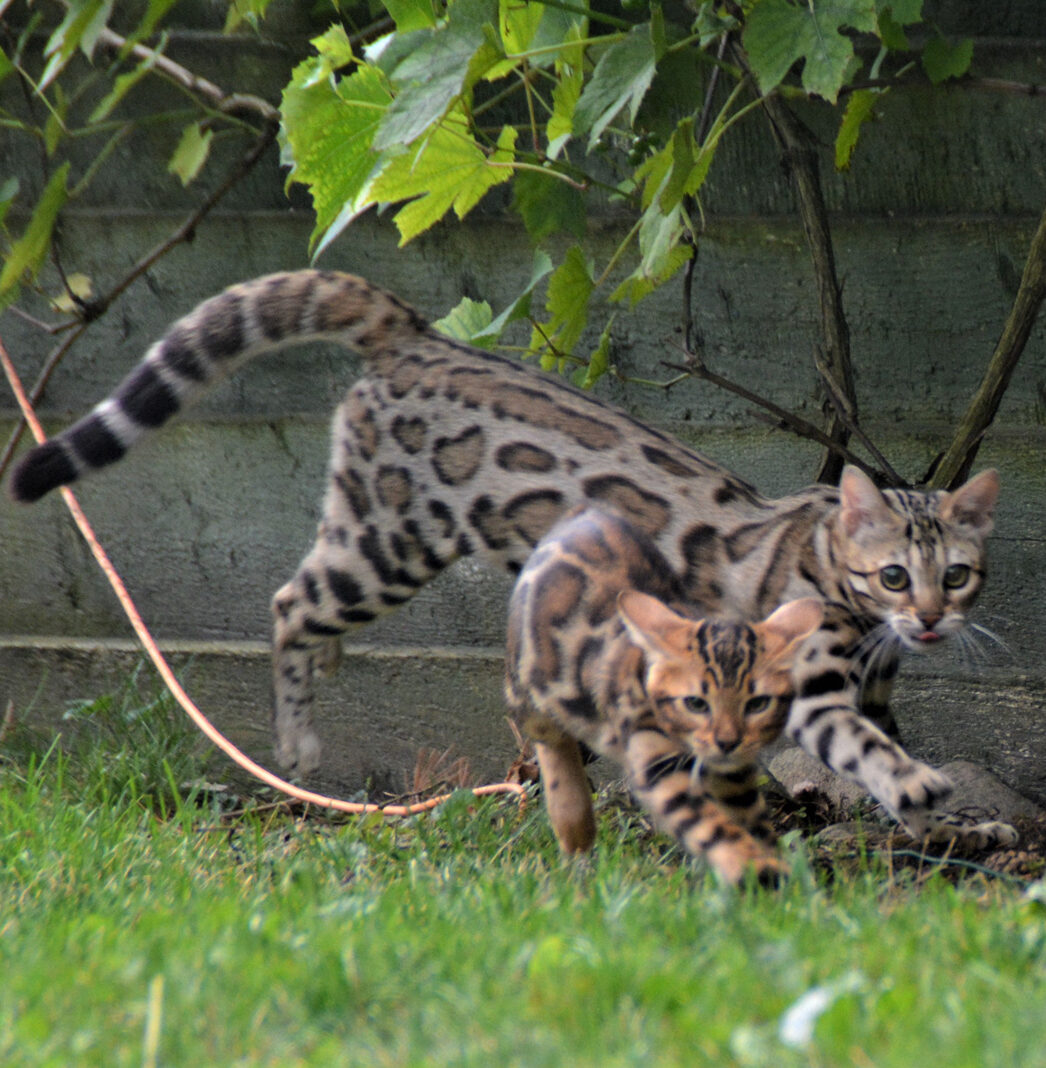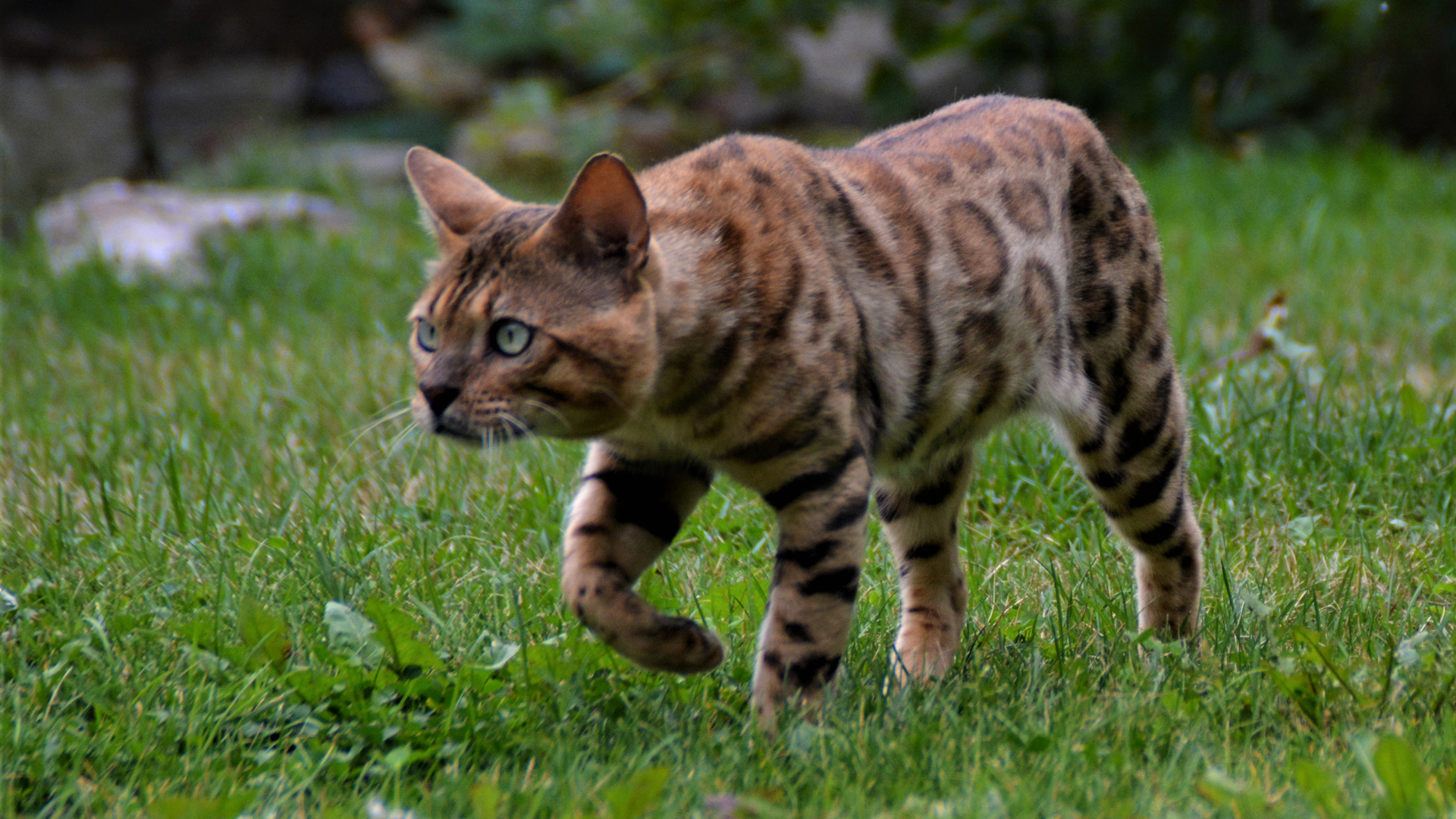
Bengal Colors & Patterns
RECOGNISED COLORS
Bengals come in a variety of colors. Classified as recognized and unrecognized colors. The three basic recognised colours are:
Brown – Silver – Snow
Brown
This colour has a large range of background colours with descriptive terms such as golden, cream, tawny, honey, taupe, buff, tan, beige, caramel or red. The brown Bengal will have black or deep brown spotted or marble pattern. Their eye colours are green or golden.
Silver
This colour has a background of almost white, silvery or silver in colour with inky black spotted or marble pattern. Their eye colour is green or golden.
Snow
This term refers to a group of colours with three distinctive genetic variations being the Seal Lynx Point, the Seal Mink and the Seal Sepia.
Seal lynx point (genetically a “cs, cs” Snow)
The SLP is the lightest of the snow group in colour and most often is born white or with very faint markings. Their pattern usually comes in later and most often starting at the points. The SLP will have a brownish-grey, tan or buff spotted or marble pattern on a white or cream background. The one very unique thing about the SLP is that they are the only Bengal colour with the clear ice blue eye colour.
Seal Mink (genetically a “cb, cs” Snow)
The SM will usually be born with a detectable pattern that will usually darken some as they grown. The colour background of the SM is usually in ivory, cream or buff with an almost caramel-chocolate tone to their spotted or marbled pattern. Sm’s have aqua or green eyes.
Seal Sepia (genetically a “cb, cb” Snow)
Are usually the darkest of the snow group and are most often born with a distinctive pattern in seal brown to dark seal brown spotted or marble pattern. The SS eye colour is golden or green.
NON-RECOGNISED COLORS
Besides the recognized colours listed above the Bengal Cat can produce other rare colours that have been brought down through the generations with recessive genes that can show up from time to time.
Charcoal
This colour while believed by some to be a separate genetic colour is also used by many as a descriptive term for the darkest range on the spectrum within the recognized colours. i.e. Charcoal Brown and Charcoal Silver. “Charcoals” have very little to no rufusing in their wild dark greyish and/or dark brownish background colour. They will have very dark (if not black) spots or marble pattern. Charcoals have dark masks and in the spotted pattern you can notice a thick back stripe running the length of their body along the back, also known as a “cape”. Breeders are also now noting the charcoal colour variation in Snows and are referring to them as “Charcoal Snows”. In the above photo album is a picture of a hybrid Jaglion that has the same dramatic feel as the charcoal Bengal.
Melanistic (Black)
This is a colour that has a black background with faint dark brown-black spotted pattern which can sometimes only be seen in natural sunlight. In the above photo album is a picture of Melanistic Jaguars for your reference.
Blue
This colour tends to have a buttery-peachy toned background colour with bluish-gray spotted or marbled pattern. The Blue Bengal’s pattern and markings will never turn black. This dilute colour is not found in the wild cat species and therefore currently not considered for inclusion in the breed.
BENGAL SPOTTED PATTERNS
While there are only two patterns under which Bengals Cats are shown (Spotted or Marble) there are descriptive terms used to define the types of pattern seen. We have compiled photos of several different Wild Cats that help show the patterns and wild look that Bengal breeders are working towards in the above photo album.
Within the spotted pattern you will hear many descriptive terms referring to the type of spotted pattern a cat or kitten might have.
The most common terms are; Single-Spotting, Cluster Rosettes, Paw-Print Rosettes, Doughnut Rosettes, Arrowhead (Rosettes), Embryonic Rosettes. All of these styles are classed for showing under “spotted”.
The rosette colour pattern is a desirable marking for Bengals Cats and has more than one shade of color in the pattern. At first glance a rosette pattern can look like a spot that fades in color towards the middle of the spot. But this is not the case. Most rosetted cats will in fact display a range of styles within the one coat pattern. it is not required that the cats pattern be solely one design of rosettes, and in fact the combination of designs lends towards that random unique look of the Bengal.
A rosette pattern has a distinct alternate colour different from the background colour that is then “outlined or edged” by a darker or different distinctive colour. Here are some examples of different styles of the spotted pattern.
Single-Spotting
Is used to define a pattern that has no second colour to the spot (there is only the background colour of the cat and the one spot colour).
Cluster Rosettes
Is used to define a pattern with small spots forming clusters around the second “inner” colour that is different from the background.
Paw-Print Rosettes
Is used when the rosette is open on one side and there are spots edging the second colour creating a pattern that looks like paw prints walking across the background.
Embryonic Rosettes
Is when the spot shows subtle signs of a second colour on the edges. (note; this pattern is also displaying the arrowhead pattern as an embryonic rosette)
Doughnut Rosettes
Is used to define a rosette that is completely or almost completely outlined with a darker colour and the center is a distinctly different colour to that of the background.
Arrowhead Rosettes
Is used when you see a spot or rosette in triangular shapes with the “tip of the arrow” pointing toward the back of the body. (note; this pattern can also be solid in the single spotted group.)
BENGAL MARBLED PATTERNS
Within the Marble pattern you will hear descriptive terms referring to the type of marble pattern a cat or kitten might have. You’ll find the most common terms below.
Tri-Colour and Quad-Colour
Describes when there are three definite colours present, the background, the marble markings and the center, like seen in a spotted doughnut rosette pattern. The same for a quad-colour pattern you will see four distinctive colours that make up the pattern and background.
Horizontal Flowing
This is used to describe when you see the marble pattern flowing from the upper shoulder along the body to the back of the cat in a horizontal fashion. This affect is much like the markings on a boa constrictor. This style of marbling is highly desired in the marble pattern.
High Acreage or Reduced Pattern
This is used to describe a pattern that has a high percentage of background colour showing behind and between the marble pattern. This has become a highly prized look and is often referred to as mimicking more closely the look of wild cats like the Margay (Leopardus wiedii) King Cheetah (Acinonyx jubatus rex) and the Marbled Cat (Pardofelis marmorata). Please refer to the above photo album of wild cats to see their sample patterns.
Chaos Pattern
Is used to describe a dramatic pattern compromised of swirls and splashes in different sizes and shapes of marbling flowing in a horizontal fashion.
Sheeted or Closed Pattern
This term is used to describe a marble pattern that has a high ratio of pattern to background colour. Sheeted marble kittens born with this high percentage of pattern can take up to two years to finish “opening up” in pattern to the “real pattern” underneath. It can be very exciting to see what is “behind” the sheeted pattern of a Bengal once the colour “matures”.
Bull’s-eye
(NOT DESIRED) A circular presentation on the marble pattern with a round center of marbling inside the circle creating a literal “bulls-eye” in the pattern on the side of the cat. This is also known as the “classic Tabby pattern” which we do not want to perpetuate in the Bengal Breed.


